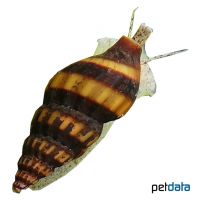Assassin Snail (Anentome helena)
| Assassin Snail Anentome helena | |
|---|---|
| Name | Assassin Snail |
| Name Lat. | Anentome helena |
| Synonym | Clea helena |
| Family | Nassa Mud Snails |
| Family lat. | Nassariidae |
| Order | Neogastropods |
| Order lat. | Neogastropoda |
| Origin | Southeast Asia |
| Habitat | Streams, pools |
| Diet | Snails |
| pH | 6.0-8.0 |
| Behavior | Predatory |
| Keeping | Individual, group |
| Care Level | Easy |
| Reproduction | Oviparous |
| Breeding | Moderately difficult |
| Life Span | 1-5 years |
| Protection | No |
| Metric Units | |
| Size | 2 cm |
| Temperature | 20-28 °C |
| Hardness | 2-15 °dH |
| Aquarium | ~ 30 l |
| US Units | |
| Size | 1" |
| Temperature | 68-82 °F |
| Hardness | 36-267 ppm |
| Aquarium | ~ 10 gal |
Distribution and habitat
The predatory lantern snail is common in Indonesia, Malaysia and Thailand. It lives in moderately flowing waters with dense vegetation, on rocky or sandy bottoms, but it has also been found near waterfalls.
Maintenance
The aquarium should have dense planting, slightly subdued light (floating plants) and a medium strong current. To be able to burrow in, they need a soft, fine-grained, 5-10 cm deep substrate (sand, round gravel), which can be covered with some foliage (e.g. sea almond leaves, oak leaves).
No ammonia, ammonium and nitrite should be detectable in the aquarium water, the nitrate value should not exceed 100 mg/l. To ensure water quality and oxygen content, a filter and heater adapted to the size of the aquarium is required, as well as lighting for the species-appropriate day-night rhythm of the animals. When choosing the filter, special care should be taken to ensure that the animals cannot be sucked in.
Diet
As the only species known so far, the predatory lace snail eats other snails. It prefers smaller species, but also attacks larger snails. Buried in the sand except for their mouth opening and proboscis, they lie in wait for snails to crawl by or track them by their slime trail. It inserts its proboscis into the shell opening of its prey to eat it. Occasionally, high-protein food pellets are also accepted as a substitute food
Unaccepted food tablets must be removed after 2-3 hours.
Behaviour and compatibility
They should not be socialized with small crayfish and shrimp, as they may be prey. With fish that do not consider snails as food, they can be well maintained in the community aquarium.
In principle, only mutually compatible species with similar requirements for water conditions and water temperature should be socialized.
Reproduction and breeding
They are separately sexed. The sexes cannot be distinguished from each other
After mating, the females attach the eggs individually to various substrates (roots, stones, etc.) in a trapezoidal, milky-white shell. Depending on the water temperature, the young hatch after about three weeks.
Important
They can be used when there is an overpopulation of, for example, bubble snails or post horn snails to reduce this population
To build up their shells they need a sufficient supply of lime. Especially in soft, acidic water, shell damage (holes) can occur due to a lack of lime, which can lead to the death of the snail. Therefore, special attention should be paid to the calcium concentration in the water and, if necessary, calcium should be added in the form of limestone, cuttlebone or special preparations from the specialized trade.
The well-being of the animals should be checked regularly. The temperature should be checked daily, the pH value, hardness and nitrate value at least every 14 days. A regular partial water change is recommended, even if the pollutant load has not yet reached the upper limit. Sudden changes in water quality should be avoided. Newly introduced animals must be accustomed slowly to the water in the aquarium.
Further literature can be found in your pet store.
References
Text: Barbara Pachner; Image: petdata
Source: BITTER (2008): Schnecken-Fibel, Dähne Verlag; ENGELMANN & LANGE (2011): Zootierhaltung - Tiere in menschlicher Obhut: Wirbellose, Verlag Harri Deutsch
